- Synthetization and investigation on mechanical characteristics of aluminium alloy 7075 with TiB2 composite
M. Manoja,*, G.R. Jinub, T. Muthuramalingamc and R. Leo Bright Singhd
aDepartment of Production Technology, MIT Campus, Anna University, Chennai, 600044, Tamilnadu, India
bDepartment of Mechanical Engineering, University College of Engineering, Nagercoil, 629004, Kanyakumari, Tamilnadu, India
cDepartment of Mechatronics Engineering, SRM Institute of Science and Technology, SRM Nagar, Kattankulathur 603203, Chennai, Tamilnadu, India
dDepartment of Mechanical Engineering, Mar Ephraem College of Engineering and Technology, Elavuvilai, 629171, Kanyakumari, Tamilnadu, IndiaThis article is an open access article distributed under the terms of the Creative Commons Attribution Non-Commercial License (http://creativecommons.org/licenses/by-nc/4.0) which permits unrestricted non-commercial use, distribution, and reproduction in any medium, provided the original work is properly cited.
The ceramic particles reinforced with aluminium metal matrix composites(AMMCs) has found its usage in various applications due to its distinct performance parameters. In the present study, an effort was made to synthesize and analyse the mechanical characteristics of TiB2 reinforced Al7075 metal matrix composites (MMCs) using stir casting technique by varying the weight percentage of TiB2. The micro Vickers hardness, tensile strength, flexural properties are considered as the performance measures in the present investigation. It was found that the addition of TiB2 could enhance the mechanical characteristics of the MMCs significantly. The enhancement in hardness of the MMCs is due to the amalgamation of rigorous reinforcement in the matrix. The TiB2 reinforcement in the matrix alloy was found to increase the tensile and flexural strength of AMMCs considerably. The TiB2 particles are consistently disseminated in aluminium matrix alloy with considerable bonding strength
Keywords: Metal Matrix Composites (MMCs), Ceramics, TiB2, Mechanical Properties
Aluminium-based particulate reinforced MMCs seemed to have a vital role in the high performance material parameters such as less weight, high formability, high electrical conductivity and corrosion resistance which find its applications in the field of automobile, aero- space, and marine. The aluminium metallic alloys is found to be used as matrix materials in various applica- tions due to its superiorcharacteristics in strength, density, stiffness, wear resistance and thermal expansion [1]. The inclusion of hard ceramic particles like SiC, Al2O3, WC, MgO, TiC, ZrO2 and B4C usedas reinforcement material in the aluminium alloy improves the mechanical properties of AMCs [2]. Various methods such as spray deposition, powder metallurgy, squeeze-casting, and stir-casting are employed in the manufacturing of MMCs. Among these methods stir-casting process is used widely by various investigators due to its advantages in formation of higher metal yield, lesser damage to parti- culate reinforcement as well as its cost-effectiveness. Out of the commonly used ceramic reinforcements, TiB2 particulates emerges better due to its superiority in various properties [3]. The aluminium alloy 7075 metal matrix composite enhances the mechanical properties. However less attention was given to provide adequate information for multi-entry reinforcements. The reinfor- cement phases were tried with different weight fraction to enhance the mechanical and metallurgical character- ization of the composite [4-6]. The addition of ceramic can enhance the mechanical behaviour of the composites [7, 8].
The mechanism of stiffer reinforcement enhances the hardness of MMCs [9, 10]. However, it is noted that only few studies are performed to find the influence of adding ceramic reinforcements on AMMCs [11, 12]. The addition of TiB2 with metal matrix composites can enhance the mechanical behavior [13, 14]. It was found that by adding ceramic reinforcements in AMMCs, Its mechanical characteristics are increased to a certain extent [14, 15]. The distribution of ceramic particles determine the mechanical characterization in metal matrix composites [16, 17]. Hence the addition of ceramic particles should be in optimal value. More inclusive will lead to agglomeration of the particles. Hence the optimal percentage of reinforcement should be identified withproper investigation [18].
From the detailed literature survey, the need of syn- thetization and investigation of ceramic particles reinforced AMMCs was instigated. Hence the present investigation focuses on developing TiB2 particles reinforced AMMCs using stir-casting process for various weight percentage of reinforcement aiming at enhancing mechanical characteristics such as tensile, micro-hardness, flexural strength on MMCs.
Selection of matrix and reinforcement
In the present work, Al7075 is chosen as matrix phase material owing to its significance in automobile, aircraft and marine industries. The chemical composition was analysed using optical emission spectrometer (OES-foundry Master-pro, Oxford, Germany). The chemical composition of Al7075 is Titanium 0.048, Silicon 0.102, Chromium 0.241, Iron 0.432, Manganese 0.104, Copper 1.483, Magnesium 2.195, Zinc 5.463 and Aluminium 89.932. The physical properties of Al7075 are Density 2.81 g/cm3, Poisson’s ratio 0.33, Hardness (HB500) 60, Elastic modulus 70-80 GPa, Tensile strength 220 MPa and Thermal conductivity 196 W/mk and that of TiB2 are Density 4.5 g/cm3, Poisson’s ratio 0.1-1.15, Hardness (knoop) 1800, Elastic modulus 510-575GPa, Tensile strength 339 MPa and Thermal conductivity 25 W/mk. The 99.5% of pure TiB2 particles was purchased from Yang Liying Corporation, Qinhuangdao city, China. The reinforced material is TiB2 that is selected with the particle size of 3 to 5 µm. The reinforcement particles are included in AMMCs under various weight percentages of 0, 2, 4, 6 and 8% via an in-situ reaction [19].
Synthetization of aluminium MMC using stir casting
The fabrication of composites carried out through stir casting setup is shown in Fig. 1. The raw material Al7075 was kept in a graphite crucible and then heated to 850 oC in an electrical furnace. The 3 to 5 µm sized powder particles was preheated at 500 oC to eliminate dampness in the reinforcement with higher the bonding between MMCs and the reinforcement material. Then the preheated TiB2 particles were gradually added to molten Al7075. In this production process, the stirring ensured the proper distribution of the mixture of com- posite. The mixing was done with the help of a rotating spindle driven by adjustable speed motor for a time duration of 15 min with the mixing speed set at a range of 150 to 250 rpm. The mixture was poured into the mold cavity with a die of size 100´100´10 mm under room temperature. Then, the samples were machined based on various ASTM standards test specimens for various mechanical investigations.
Measurement of performance measures
The samples tested for tensile properties were made according to the ASTM standard and tested in a computerised Unitek 94100 UTM (Manufactured by Jinun testing equipments, Jinan, China). Based on the requirements of tensile testing guidelines of ASTM: E8/E8M, the samples were machined into a flat plate before measuring the tensile strength. To predict the tensional property, the specimen was tested in room temperature. Three difference sets of specimen samples were tested and the average value was taken to reduce the recurring error.The polished specimens of Al7075 alloy and its composites were subjected to micro Vickers hardness test by suitable standard testing procedure with the applied load of 0.3 kg for a period of 10 seconds in order to find the hardness. The average value of hardness test was taken to reduce the error. The flexural nature of MMCs was calculated using flexural test. This test evaluate the measurement of materials subjected to simple bending loads. Flexural test samples were tested in a Computerised UTM as per the requirements of the specimen developed under ASTM: A-370 standard. The samples were polished using standard metallographic technique (Initial polishing with different grades of emery sheets 240, 320, 400, 600 and 800 grits and fine polishing with diamond paste up to 2 µm size) and etched with Keller’s reagent to obtain a superior contrast (95 mL Distilled water, 2.5 mL Nitric Acid (HNO3), 1.5 mL Hydro Chloric Acid (HCL), 1.0 mL Hydrofluoric acid (HF) [16]. The acid liquids were purchased from merck KGaA, Darmstadt, Germany. The etched specimens were observed using an optical microscope (SMETCO RMM-88). The scanning electron microscope (SEM) investigation was carried out (TESCAN instrument provided with Vega TC software).

|
Fig. 1 Schematic diagram of Stir casting setup. |
Mechanical characterisation of Al7075/TiB2 MMC
The work carried out in this research has portrayed an effort to synthesize TiB2 reinforced AMMCs for various weight percentage (0, 2, 4, 6, and 8%) using stir casting technique. The experimental investigations were carried out to ascertain various properties such as tensile strength, hardness and flexural nature of synthesized MMCs and are discussed under this section.
Tensile strength analysis of Al7075/TiB2 composites
The mechanical behaviour of the composites were analysed using tensile test with the help of computerized UTM, Fig. 2 shows the impact of adding TiB2 reinfor- cement particles to yield strength (YS) and Ultimate Tensile Strength (UTS) of AMMCs. The observation from the tensile test substantiates the increment in the weight % of the reinforcement by the added yield strength and ultimate tensile strength. When compared with aluminium, the mechanical properties of the composites are found to have improved significantly as a result of adding TiB2 particles to the matrix. Increasing the weight % of TiB2 has a stellar role in the mechanical properties. Table 1 gives a clear view on the added weight % of TiB2. The % elongation of AMMCs is decreased as 76% with better % of TiB2 reinforcement in the MMCs as indicated in Fig. 3. This is due to the addition of ceramic reinforcement TiB2 particles which results in the reduction of elastic deformation and subsequent increment in the plastic deformation of metal matric composites.
Hardness analysis of Al7075/TiB2 composites
From the Micro Vickers based hardness measurement, it was observed that Al7075/TiB2 metal matrix com- posite can be increased to base alloy with the addition of TiB2 as shown in Table 2. The hardness of AMMCs is significantly increased with higher weight % of ceramic particulates in the matrix alloy due to the presence of TiB2 particles which is shown in Fig. 4. Hence the microstructure of matrix can be refined with improvement in the bonding which is a major factor for improving hardness.
Flexural strength of Al7075/TiB2 composites
The flexural properties of aluminum were estimated using 3-point bending test with various weight percentage to the additions of TiB2. In 3-point bending test, the maximum bending load was assessed. Fig. 5 gives the image of test specimens subjected to 3-point bending test.

Where σmax is the flexural stress, M is bending moment, I is the moment of inertia and y is distance from the neutral axis. The maximum flexural surface stress occurs in the mid-point of the specimen.
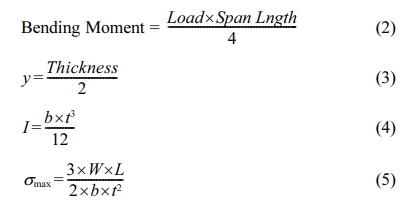
Where W is the load applied by the testing machine, t is the thickness of the specimen, b is the breath of the specimen and L is the span length.

Where W is the load applied by the testing machine, I is the moment of inertia, L is the span length and E is bending modulus.

The flexural related performance measures are computed using the Eq. (1 to 7) furnished above and tabulated as shown in Table 3.
The flexural strength of the composites obtained from three point bending test is shown in Fig. 6. It was found that the flexural strength is increased with the addition of stiffer TiB2 particles. The inclusion of TiB2 to aluminum alloys increase the flexural characteristics due to the addition of higher strength ceramic particles [12].
Microstructure of Al7075/TiB2 MMC’S
The estimation of microstructural characterization of Al7075/TiB2 MMCs is done using optical microscope with varying weight percentage (0%, 2%, 4%, 6% and 8%) of TiB2 particles. The surface morphology of synthesized AMMCs of cast specimens is estimated under etched conditions. The microstructural analysis shows uniform distribution of reinforced particles throughout the specimen samples. The accumulation of reinforced particles and grain boundaries of primary alpha aluminium matrix was investigated. The inter-dendrite pattern of grains observed in Fig. 7 clearly indicates the presence of precipitated and deposited reinforcement particle at the intersection of the grain boundaries. The reinforced particles are indicated using dark coloured pattern. Due to the non-transparent nature of the reinforced particles, the ceramic particles reflects as black spots in the MMCs surface. The weight % of reinforcement added in this study proves to create a minimal effect in the distribution, which may have negative effects if the weight % is increased beyond a certain limit. The SEM images of casted Al7075-TiB2 metal matrix composites by varying its weight percentage (0%, 2%, 4%, 6% and 8%) of reinforcement particles that are depicted in Fig. 8. It is ensured that the harder and stiffer TiB2 ceramic particles are uniformly distributed in the matrix alloy of aluminium MMC. Due to the considerable bonding strength of strongest reinforcement particles and matrix alloy, the strengthening mechanism of grain boundaries can also be enhanced considerably. The uniform distribution reduce the agglomeration of reinforcement cluster in the matrix alloy. Hence the strength of the ceramic particles in the aluminium matrix alloy is uniformly distributed over the composite specimens. It can enhance the mechanical characteristics of MMCs.
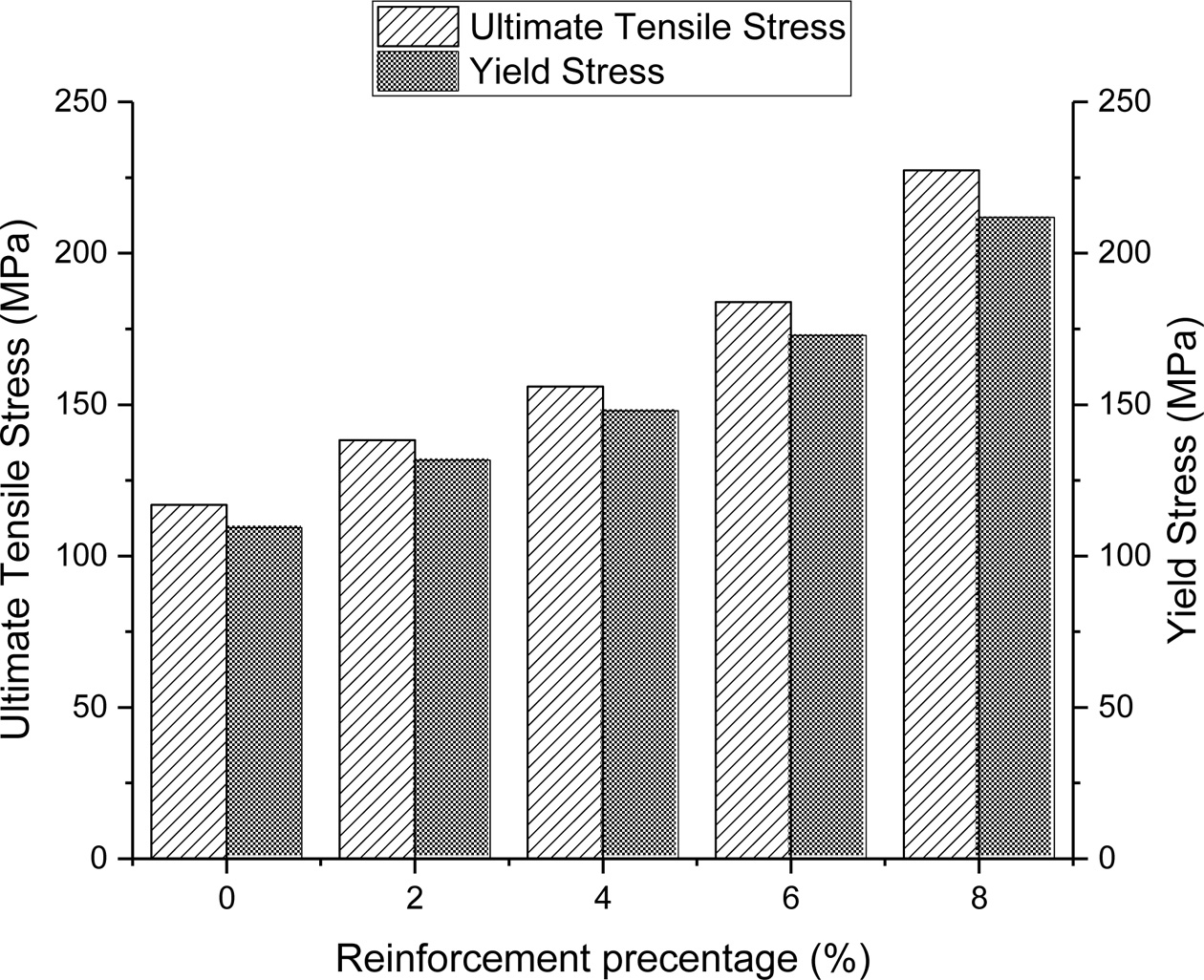
|
Fig. 2 Effect of reinforcement on tensile and yield strength of Al7075/TiB2 MMC. |
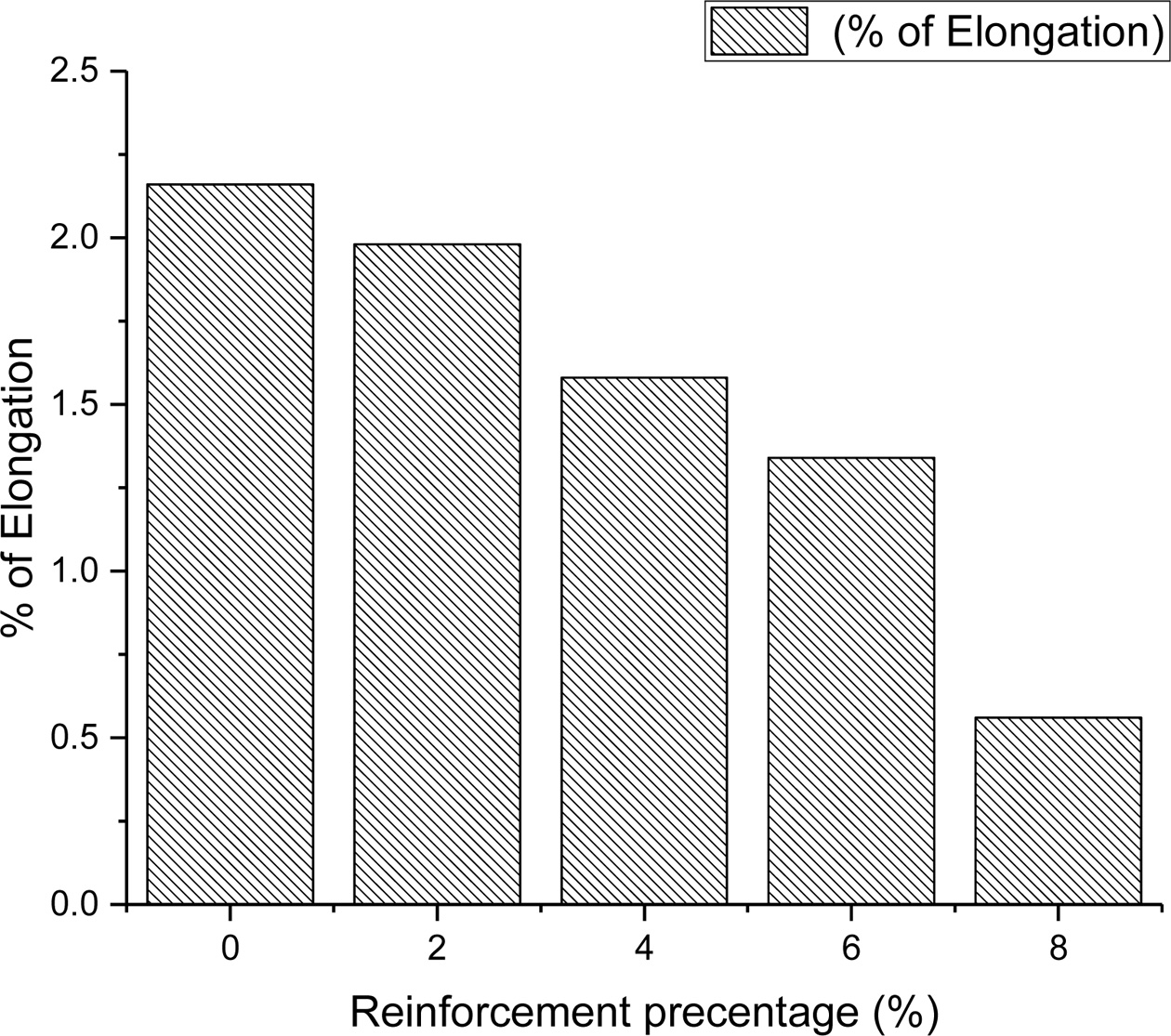
|
Fig. 3 Effect of reinforcement on % elongation of Al7075/TiB2 MMC. |

|
Fig. 4 Effect of reinforcement on hardness of Al7075/TiB2 MMC. |

|
Fig. 5 Three point bending test specimen |

|
Fig. 6 Effect of reinforcement on flexural strength of Al7075/TiB2 MMC. |

|
Fig. 7 Micro structural characterization of Al-MMC with different weight percentage of TiB2 particles reinforcement using Optical microscope. |
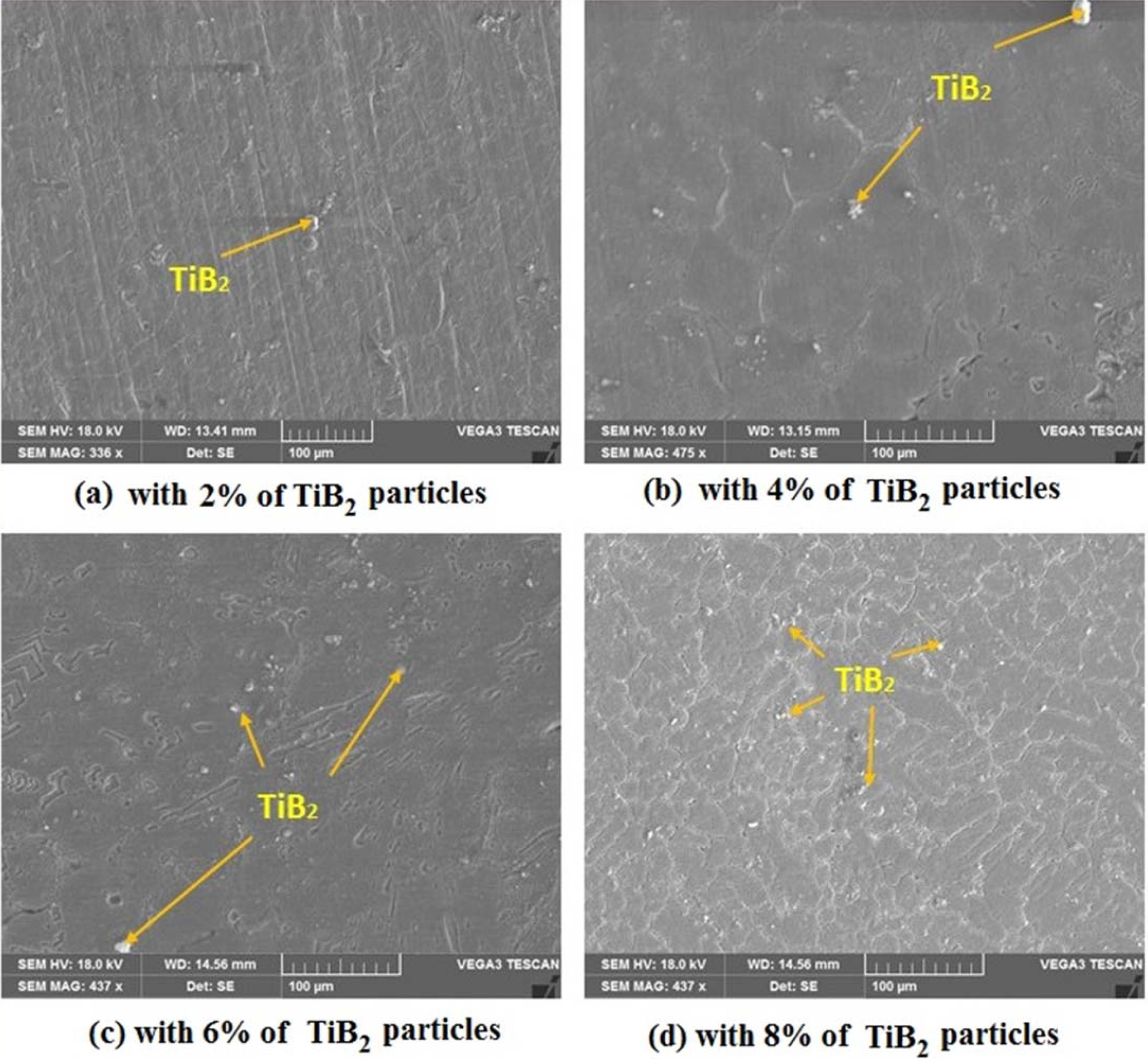
|
Fig. 8 Micro structural characterization of Al-MMC with different weight percentage of TiB2 particles reinforcement using scanning electron microscope. |
In the present investigation, an empirical study was performed to synthesize and analyze the mechanical characteristics of TiB2 reinforced Al7075 MMCs using stir casting technique under various weight percentage (0%, 2%, 4%, 6% and 8%) of TiB2. From the experimental study, the following conclusion is made.
● The TiB2 reinforcement can enhance the mechanical measures of the MMC considerably.
● The reinforcement is found to increase the hardness of the composites because of amalgamation of robust and strong reinforcement in the MMCs.
● Adding TiB2 reinforcement to the matrix composites surges the tensile and flexural properties of AMMCs.
● The TiB2 particles are consistently disseminated in aluminium matrix alloy with considerable bonding strength.
● The different ceramic reinforcement particles may be used to further enhance the performance measures.
The authors owe their sincere thanks and gratitude to Department of Production Technology, MIT campus, Anna University, Chennai, India for providing facility of Flexural test equipment utilized under DST-SERB-ECR/AS/2016/002066 towards this research work.
There is no conflict of interest in the present study.
- 1. S. Suresh, N.S.V. Moorthi, S.C. Vettivel, N. Selvakumar, and G.R. Jinu, Mater. Sci. Eng. A. 612 (2014) 16-27.
-

- 2. B.S. Yigezu, M.M. Mahapatra, and P.K. Jha, J. Miner. Mater. Char. Eng. 1[4] (2013) 124-130.
-

- 3. C.S. Ramesh, B.H. Abrar Ahamed, R. Channabasappa, and R. Keshavamurthy, Mater. Des. 31[4] (2010) 2230-2236.
-

- 4. N. Panwar and A. Chauhan, Mater. Today. 5[2] (2018) 5933-5939.
-

- 5. R. Sharma, S.J. P, K. Kakkar, K. Kamboj, and P. Sharma, Int. Res. J. Eng. Technol. 4 (2017) 832-842.
-

- 6. N. Gangil, A.N. Siddiquee, and S. Maheshwari, J. Alloys Compd. 715 (2017) 91-104.
-

- 7. S.T. Mavhungu, E.T. Akinlabi, M.A. Onitiri, and F.M. Varachia, Procedia Manuf. 7 (2017) 178-182.
-

- 8. P. Nanthakumar, A. Rajadurai, and T. Muthuramalingam, Mater. Res. Express. 5[4] (2018) 045303.
-

- 9. C.T. Lynch and J.P. Kershaw in “Metal Matrix Composite” (CRC, 2018) p.1-170.
-

- 10. Y., Sumankant, C.S. Jawalkar, A.S. Verma, and N.M. Suri, Mater. Today. 4[2] (2017)2927-2936.
-

- 11. M.O. Bodunrin, K.K. Alaneme, and L.H. Chown, J. Mater. Res. Technol. 4[4] (2015) 434-445.
-

- 12. A. Baradeswaran and A. Elya Perumal, Compos. B. Eng. 56 (2014) 464-471.
-

- 13. S. Suresh and N. Shenbag, V. Moorthi, Procedia. Eng. 38 (2012) 89-97.
-

- 14. S. Liu, Y. Wang, T. Muthuramalingam, and G. Anbuchezhiyan, Comp. B. Eng. 176 (2019) 107329.
-

- 15. C. Fenghong, C. Chang, W. Zhenyu, T. Muthuramalingam, and G. Anbuchezhiyan, Silicon 11[6] (2019) 2625-2632.
-

- 16. M. Manoj, G.R. Jinu, and T. Muthuramalingam, Silicon 10[5] (2018) 2287-2293.
-

- 17. A.E. Perumal, G.R. Jinu, S. Vidhyalakshmi, and S.A.B. Jude, J.Ceram. Process. Res. 21[5] (2020) 524-532.
-

- 18. P. Nanthakumar, A. Rajadurai, and T Muthuramalingam Silicon 10[4] (2018) 1723-1729.
-

- 19. G. Karthikeyan and G.R. Jinu, T. FAMENA 39[4] (2015) 89-98.
 This Article
This Article
-
2021; 22(4): 475-481
Published on Aug 31, 2021
- 10.36410/jcpr.2021.22.4.475
- Received on Feb 3, 2021
- Revised on Mar 31, 2021
- Accepted on Apr 19, 2021
 Services
Services
- Abstract
introduction
materials and methods
results and discussion
conclusion
- Acknowledgements
- Conflict of Interest
- References
- Full Text PDF
Shared
 Correspondence to
Correspondence to
- M. Manoj
-
Department of Production Technology, MIT Campus, Anna University, Chennai, 600044, Tamilnadu, India
Tel : +919600218785 - E-mail: royalmanoj88@gmail.com







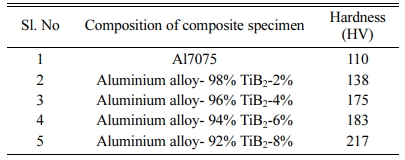

 Copyright 2019 International Orgranization for Ceramic Processing. All rights reserved.
Copyright 2019 International Orgranization for Ceramic Processing. All rights reserved.